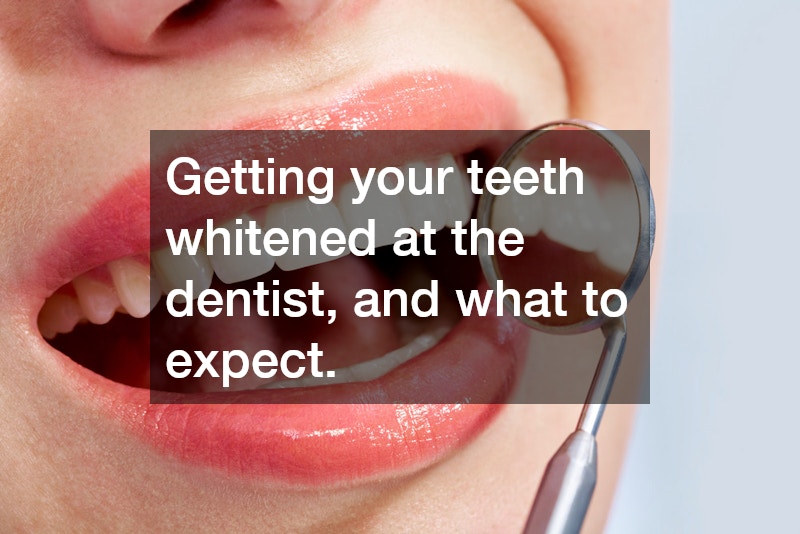
A bright, confident smile can change how you feel about yourself and how others see you. Teeth whitening is one of the most popular cosmetic dental treatments today, and many people turn to a professional dentist for safe, effective, and fast results. If you have ever wondered what really happens during a whitening appointment, or what to expect before, during, and after the procedure, here is everything you need to know.
Understanding Professional Teeth Whitening
Teeth naturally become discolored over time due to coffee, tea, wine, smoking, and even certain foods. Aging also plays a part, as the enamel thins and allows the yellowish dentin underneath to show through. While there are countless over-the-counter whitening kits and toothpaste products available, professional whitening at the dentist offers a level of strength, precision, and safety you simply cannot get at home.
Your dentist uses higher concentrations of whitening agents such as hydrogen peroxide or carbamide peroxide than what is found in store-bought products. The procedure is designed to break apart deep stains within the tooth structure and restore a brighter, whiter shade in a controlled and predictable way.
The Consultation and Preparation Phase
Before any whitening begins, your dentist will schedule a consultation to make sure you are a good candidate for treatment. During this visit, they will check for issues like cavities, gum disease, or exposed roots. Whitening agents can irritate unhealthy gums or sensitive teeth, so addressing any underlying problems first is essential.
Your dentist will also discuss your goals and shade expectations. Many offices use a shade guide to compare your current tooth color and the desired result. This helps set realistic expectations — professional whitening can lift your teeth several shades lighter, but not every stain can be completely erased.
Sometimes, your dentist will recommend a professional cleaning before whitening. This removes surface plaque and tartar, ensuring the whitening gel can make even contact with the tooth surface for an even, consistent result.
What Happens During the Procedure
Once your teeth are clean and ready, the whitening session begins. Here is a breakdown of what typically happens during an in-office treatment:
Preparation:
Your lips and gums are protected using retractors, cotton rolls, or a special rubber barrier. This isolates the teeth and prevents the whitening gel from contacting soft tissues.
Application of Whitening Gel:
The dentist carefully applies the whitening agent to each tooth. The gel may contain hydrogen or carbamide peroxide, which releases oxygen molecules that break down stains.
Activation:
Some whitening systems use a special light or laser to speed up the chemical reaction and enhance results. Others rely on the gel alone to work over time.
Multiple Rounds:
The gel stays on your teeth for about 15 to 30 minutes per round. Depending on the level of discoloration, your dentist may repeat the application several times during the same visit.
Rinse and Reveal:
Once the process is complete, the dentist removes the gel, rinses your mouth, and compares your new shade to the original color chart. Most patients notice an immediate improvement.
The entire visit typically lasts between 60 and 90 minutes. You will leave the office with noticeably whiter teeth and instructions for post-treatment care.
What to Expect After Whitening
After the procedure, it is normal for teeth to feel slightly sensitive for a day or two. This happens because the enamel temporarily becomes more porous after whitening. Your dentist may provide a fluoride rinse or sensitivity toothpaste to help soothe any discomfort.
For the first 48 hours, you should avoid foods and drinks that can stain your teeth. This includes coffee, tea, red wine, dark sauces, and berries. The general rule is simple: if it can stain a white shirt, it can stain freshly whitened teeth. Drinking through a straw and rinsing your mouth with water after meals can also help maintain your results.
Your newly whitened smile can last anywhere from six months to two years, depending on your habits and oral hygiene. Regular brushing, flossing, and routine dental visits are key to keeping your teeth bright. Many patients choose to schedule a quick touch-up session every six to twelve months to maintain their ideal shade.
At-Home Maintenance Options
Your dentist may also offer take-home whitening kits to maintain your results. These kits include custom-fitted trays and professional-grade whitening gel that you can use safely at home. Unlike store-bought strips or gels, these trays ensure even coverage and reduce the risk of gum irritation.
Using the at-home trays for just a few days can refresh your smile whenever it starts to dull. Your dentist can guide you on how often to use them, depending on the level of whitening you desire and your tooth sensitivity.
Common Myths and Misconceptions
Myth 1: Whitening damages enamel.
Professional whitening does not harm healthy enamel when done under the supervision of a dentist. The active ingredients target stains, not the structure of your teeth.
Myth 2: It works the same for everyone.
Whitening results vary depending on genetics, lifestyle, and the type of stains. For instance, yellowish stains respond better than gray or brown ones.
Myth 3: Once whitened, teeth stay white forever.
Whitening is not permanent, but proper maintenance and healthy habits can prolong your results.
The Confidence Boost
Beyond the science, whitening your teeth can have a huge psychological benefit. Many people find that a brighter smile improves their self-esteem and helps them feel more comfortable in social or professional situations. Whether you have an upcoming wedding, interview, or simply want to feel more confident, visiting your dentist for whitening is a simple yet powerful way to make a lasting impression.
Final Thoughts
Getting your teeth whitened at the dentist is one of the fastest and safest ways to achieve a noticeably brighter smile. From the initial consultation to post-treatment care, every step is designed for comfort, safety, and long-lasting results. While at-home products can help maintain your look, nothing matches the precision and effectiveness of professional whitening.



